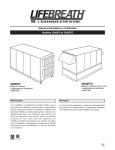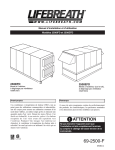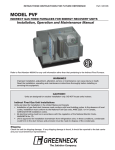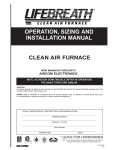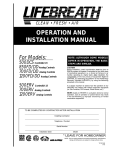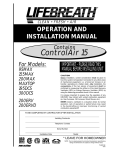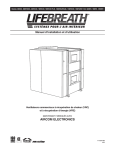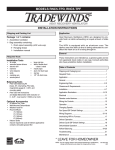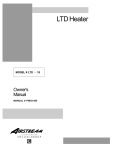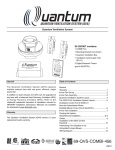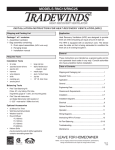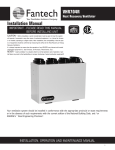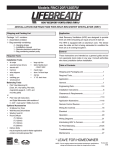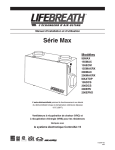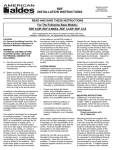Download Lifebreath 2500IFD User's Manual
Transcript
OPERATION AND INSTALLATION MANUAL For Models: 2500IFD 2500EFD APPLICATION WARNING!!! CAUTION Before installation, careful consideration must be given to how the system will operate if connected to any other piece of mechanical equipment, i.e. a forced air furnace or air handler, operating at a higher static. After installation, the compatibility of the two pieces of equipment must be confirmed, by measuring the airflow’s of the Heat Recovery Ventilator (HRV), by using the balancing procedure in this manual. It is always important to assess how the operation of any HRV may interact with vented combustion equipment. NEVER install an HRV in a situation where its normal operation, lack of operation or partial failure may result in the backdrafting or improper functioning of vented combustion equipment!!! Do Not Attempt Installing Unit Without First Reading Entire Manual. TI-59 0201 INTRODUCTION Table of Contents These Heat Recovery Ventilators (HRVs) are designed for commercial and industrial applications to provide fresh air to a building while exhausting an equal amount of stale air. During the winter months the incoming cold fresh air is warmed by utilizing the heat recovered from the stale air before it is exhausted to the outdoors. During summer months when the indoor space is air conditioned, the Heat Recovery Ventilator will help in cooling the incoming fresh air with the stale air that is being exhausted. Introduction .................................................................... 2 Select Correct HRV......................................................... 3 Specifications - Model 2500IFD .................................. 4 Options & Accessories ....................... 5 Specifications - Model 2500EFD ................................. 6 Options & Accessories ....................... 7 Operation Instructions ................................................... 8 Installation Tips ............................................................. 8 Remote Controls ........................................................... 9 2500 I F D User Adjustable Defrost ................................................ 9 Defrost Control .............................................................. 9 Interior mount Fan Fan Defrost ................................................................. 10 Defrost Location ...................................................................... 10 Mounting ..................................................................... 10 Drains ......................................................................... 13 2500 E F D Ducting ......................................................................... 13 Return and Supply ....................................................... 14 Exterior (roof mount) Fan Air Flow Balancing ....................................................... 15 Defrost The Integrated HVAC System ...................................... 16 Electrical Connections ................................................. 16 Maintenance ................................................................ 16 Wiring Diagram ........................................................... 18 Warranty .................................................................... 19 2 Selecting the Correct Size HRV Commercial and Institutional Requirements For outdoor air requirements, ASHRAE has produced the Ventilation Standard 62-1989 that is used to determine acceptable ventilation rates. This standard is referenced directly or used as “Good Engineering Practice” in most Code documents or design criteria. Small restaurants, Donut Shops and Fast food stores Seats 40 Employees 5 Total 45 ASHRAE requirement 20 cfm (10L/s) per person Ventilation required 45 x 20 = 900 cfm (450 L/s) Bank Customers 25 Staff 9 Total 34 ASHRAE requirement Ventilation required 20 cfm (10L/s) per person 34 x 20 = 680 cfm (320 L/s) Bar or Tavern Seats 50 Employees 7 Total 57 ASHRAE requirement Ventilation required Bingo Hall Customers 180 Staff 20 Total 200 ASHRAE requirement Ventilation required 30 cfm (15L/s) per person 200 x 30 = 6000 cfm (3000 L/s) Print Shop, Duplicating Square footage of shop 2000 square ft (m2) 30 cfm (15L/s) per person 57 x 30 = 855 cfm (403 L/s) Classroom and School Portables Seats 29 Teacher 1 Total 30 ASHRAE requirement 15 cfm (7.5L/s) per person Ventilation required 30 x 15 = 450 cfm (255 L/s) Beauty Salon Customers 12 Employees 6 Total 18 ASHRAE requirement Ventilation required ASHRAE requirement 0.5 cfm/ft2 (2.5L/s - m2) per person Ventilation required 2000 x 0.5 = 1000 cfm (500 L/s) Swimming Pools Refer to “Pool” Models Installation Manuals. 25 cfm (12.5L/s) per person 18 x 25 = 450 cfm (255 L/s) MAKE UP HEAT REQUIREMENT at 1200 CFM (566L/s) Outdoor Temp. C° F° 0 -10 -20 -30 -40 32 14 -4 -22 -40 Nominal kW Req. for 20°C (68°F) Air Delivery 7 10 12 15 17 3 Nominal kW Req. for 25°C (77°F) Air Delivery Nominal kW Req. for 30°C (86°F) Air Delivery 10 14 15 19 21 14 17 19 22 24 Model 2500IFD SPECIFICATIONS AIR FLOW 2100 cfm (985 L/s) at 1.0"wg ESP PERFORMANCE 70% effective at 2500 cfm (1172 L/s) Supply from Outside Exhaust to Outside 4" Filters CORE Modular aluminum sensible heat recovery core. Plate-to-plate type. Slides out of either side of cabinet for service. Motors (2) MOTORS Two single shaft PSC, 3-speed, 208/230V,5.1 amps, 1 ph, 1 hp Exhaust from Building BLOWERS Two direct-drive centrifugal blowers, one per air stream. Heat Exchange Core Supply to Building FILTERS Two 18" X 24" 4-inch pleated filters in each air stream. Drain Pans (2) DUCT CONNECTIONS Four 24" X 16" (610mm X 406mm) Heat Exchanger Service Panel* Electrical Service Panel* CABINET 20 gauge powder coated galvanized steel (G60) for superior corrosion resistance. 16 gauge galvanized frame, insulated with 1.5" fibreglass insulation to prevent condensation. DRAIN Two stainless steel drain pans with 1/2" NPT drain spouts. Filter Service Panel* 47" 89.9" SIDE VIEW MOUNTING Unit to be set on support brackets hung by threaded rod type apparatus. Brackets and rod not provided. *NOTE: Removable service access panels on both sides of 2500IFD cabinet. Supply from outside CONTROLS 24V terminal strip inside electrical box, to connect optional remote controls (not included), obtain on/off and high/low functions. Exhaust to outside DEFROST Factory set defrost time (user adjustable). Supply motor is shut off while exhaust air defrosts core. 38.4" 38.4" 24" 24" 2" 7" 47" WARRANTY 15 year warranty on heat exchanger, and 2 years on parts. Supply to building 16" 16" 6" WEIGHT 700 lbs. Exhaust from building FRONT VIEW SHIPPING WEIGHT 1100 lbs. BACK VIEW All units conform to CSA and UL standards. DATE: __________________________ PROJECT: ________________________________________ MECHANICAL CONTRACTOR: ________________________________ 4 511 McCormick Blvd. London, Ontario N5W 4C8 Ph: (519) 457-1904 Fx: (519) 457-1676 Email: [email protected] Website: www.lifebreath.com TI-91I 0103 PERFORMANCE AIRFLOWS (Each Air Stream) AIRFLOW L/s (CFM) 1316 (2800) HIGH SPEED 1175 (2500) 1034 (2200) 893 (1900) MEDIUM SPEED LOW SPEED 752 (1600) 611 (1300) 470 (1000) 329 (700) 188 (400) 47 (100) 25 50 75 100 125 150 175 200 225 250 275 300 325 350 375 (0.1) (0.2)(0.3) (0.4) (0.5) (0.6) (0.7) (0.8) (0.9) (1.0) (1.1) (1.2) (1.3) (1.4) (1.5) 400 425 450 475 500 525 550 (1.6) (1.7) (1.8) (1.9) (2.0) (2.1) (2.2) EXTERNAL STATIC PRESSURE IN PASCALS (in. W.C.) EFFECTIVENESS TEMPERATURE EFFECTIVENESS 70% 60% 50% NOTE: Exhaust Relative Humidity (RH) at 40% 850 944 1039 1133 1228 1322 1416 (1800) (2000) (2200) (2400) (2600) (2800) (3000) AIRFLOW IN L/s (CFM) OPTIONS AND ACCESSORIES 99-101: CRANK TIMER Mechanical timer to activate high speed. 99-116: DEHUMIDISTAT VENTILATION CONTROL (DVC) Turns unit on/off via slider switch and high/low via built-in dehumidistat. Roof Curb (optional) 99-130: DEHUMIDISTAT Activates high speed when indoor humidity rises above set point on control. Part No. 53-2500 Supply air opening 99-140: 4" TECHGRILLE 99-141: 5" TECHGRILLE 99-142: 6" TECHGRILLE 99-148: 8" TECHGRILLE Round, white, step-type diffusers. Duct Collar Supports 88.25" 36.9" 14" 53-2500: OPTIONAL ROOF CURB Supports HRV on roof and connects HRV to ducting below. WEIGHT: 50lbs Return air opening Information about design-built electric make-up heat coils available upon request. 5 Factory installed perimeter wooden nailer strip TI-91I 0103 Model 2500EFD (ROOFTOP) SPECIFICATIONS AIR FLOW 2100 cfm (985 L/s) at 1.0"wg ESP PERFORMANCE 70% effective at 2500 cfm (1172 L/s) CORE Modular aluminum sensible heat recovery core. Plate-to-plate type. Slides out of either side of cabinet for service. Exhaust Hoods Supply Hoods Hoods (2) c/w Bug Screen MOTORS Two single shaft PSC, 3-speed, 208/230V,5.1 amps, 1 ph, 1 hp 4" Filters Motors (2) BLOWERS Two direct-drive centrifugal blowers, one per air stream. Roof Curb Exhaust Duct 24"x16" FILTERS Two 18" X 24" 4-inch pleated filters in each air stream. Heat Exchange Core Supply to Duct 24"x16" DUCT CONNECTIONS Four 24" X 16" (610mm X 406mm) to and from the building under cabinet. Four 28" X 18" (711mm X 457mm) hoods included on side of cabinet with screens. CABINET 20 gauge powder coated galvanized steel (G60) for superior corrosion resistance. 16 gauge galvanized frame, insulated with 1.5" fibreglass insulation to prevent condensation. Drain Pans (2) Heat Exchanger Service Panel* Electrical Service Panel* Filter Service Panel* 18" 47" 18" 27" DRAIN Two stainless steel drain pans with 1/2" NPT drain spouts. 89.9" MOUNTING Rooftop mounted on optional roof curb (Part No. 53-2500) SIDE VIEW CONTROLS 24V terminal strip inside electrical box, to connect optional remote controls (not included), obtain on/off and high/low functions. *NOTE: Removable service access panels on both sides of 2500EFD cabinet. 62.7" DEFROST Factory set defrost time (user adjustable). Supply motor is shut off while exhaust air defrosts core. Bottom duct connections 16" X 24" WARRANTY 15 year warranty on heat exchanger, and 2 years on parts. 38.4" 28" 19.2" WEIGHT 700 lbs. 15.2" SHIPPING WEIGHT 1100 lbs. TOP VIEW OPTIONAL CURB WEIGHT 50 lbs. 12" Supply Return Exhaust All units conform to CSA and UL standards. DATE: __________________________ 511 McCormick Blvd. London, Ontario N5W 4C8 PROJECT: ________________________________________ MECHANICAL CONTRACTOR: ________________________________ 6 Ph: (519) 457-1904 Fx: (519) 457-1676 Email: [email protected] Website: www.lifebreath.com TI-91E 0103 PERFORMANCE AIRFLOWS (Each Air Stream) AIRFLOW L/s (CFM) 1316 (2800) HIGH SPEED 1175 (2500) 1034 (2200) 893 (1900) MEDIUM SPEED LOW SPEED 752 (1600) 611 (1300) 470 (1000) 329 (700) 188 (400) 47 (100) 25 50 75 100 125 150 175 200 225 250 275 300 325 350 375 (0.1) (0.2)(0.3) (0.4) (0.5) (0.6) (0.7) (0.8) (0.9) (1.0) (1.1) (1.2) (1.3) (1.4) (1.5) 400 425 450 475 500 525 550 (1.6) (1.7) (1.8) (1.9) (2.0) (2.1) (2.2) EXTERNAL STATIC PRESSURE IN PASCALS (in. W.C.) EFFECTIVENESS TEMPERATURE EFFECTIVENESS 70% 60% 50% NOTE: Exhaust Relative Humidity (RH) at 40% 850 944 1039 1133 1228 1322 1416 (1800) (2000) (2200) (2400) (2600) (2800) (3000) AIRFLOW IN L/s (CFM) OPTIONS AND ACCESSORIES 99-101: CRANK TIMER Mechanical timer to activate high speed. 99-116: DEHUMIDISTAT VENTILATION CONTROL (DVC) Turns unit on/off via slider switch and high/low via built-in dehumidistat. Roof Curb (optional) 99-130: DEHUMIDISTAT Activates high speed when indoor humidity rises above set point on control. Part No. 53-2500 Supply air opening 99-140: 4" TECHGRILLE 99-141: 5" TECHGRILLE 99-142: 6" TECHGRILLE 99-148: 8" TECHGRILLE Round, white, step-type diffusers. Duct Collar Supports 88.25" 36.9" 14" 53-2500: OPTIONAL ROOF CURB Supports HRV on roof and connects HRV to ducting below. WEIGHT: 50lbs Return air opening Information about design-built electric make-up heat coils available upon request. 7 Factory installed perimeter wooden nailer strip TI-91E 0103 Operation Instructions Installation Tips The LIFEBREATH 2500 series HRV is designed tobe operated continuously or intermittently to meet the requirements of the application. 1. Whichever method is chosen to operate the 2500, keep in mind that Air-to Air exchangers in general are not "booster fans" and are normally sized to ventilate at a steady rate. CONTINUOUS OPERATION To achieve optimum performance from the 2500, the desired ventilation rate (speed of the system) should be reached before the contaminant to be removed has reached its maximum. For continuous operation, a simple jumper across the ON/OFF and COMMON jumper terminals is needed. HIGH/LOW speed selection requires another jumper across HIGH/LOW and COMMON; select as required (see below and wiring diagram). EXAMPLE: A bingo hall opening at 7:00PM that is sized for 5000 cfm should have at least this amount of air exchange by that time. If the unit is not turned on or set to its designated speed until after the contaminant has reached an uncomfortable level, then it may result in a number of hours passing before the system could catch up. T3 - On/Off ON/OFF T2 - High/Low 2. It is highly recommended that back draft dampers be installed in the supply and exhaust duct work to the outside, to prevent air from entering in through the HRV when the unit is off. Failure to install back draft dampers may result in damage to HVAC equipment and/or other building components. HIGH/LOW T1 - Common Low Voltage-24VAC INTERMITTENT OPERATION Due to variance in the times in which buildings are occupied and equipment or machinery operated, intermittent ventilation may be the preferred method. Dry contacts located inside the electrical panel enable this unit to turn ON and OFF, and/or jump between HIGH and LOW speeds when optional low voltage controls are connected (see above and pg. 9). OPTIONAL REMOTE CONTROLS Basic controls such as dehumidistats, mechanical crank timers, 24-hour timers or toggle switches can be used to control the unit (see pg. 9). 8 Optional Remote Controls DEHUMIDISTAT VENTILATION CONTROL* LOCATION: Spa or pool area, anywhere that humidity is a concern. (connect 1/unit only) • Ventilation control turns HRV system OFF and ON. • Dehumidistat increases ventilation when required Red - common / Black - hi/low / Orange - on/off PART NO. 99-116 c/w 3 wire cable 60' (18m) ON OFF HIGH REMOTE DEHUMIDISTAT LOCATION: Spa or pool area, anywhere that humidity is a concern. • Provides high speed ventilation when humidity level exceeds selected setting. PART NO. 99-130 istat Dehumid to Relative Setting ns Conditio Outside WINTER: midistat Set dehu to 40%. 30% between is too dry, If home ng. higher setti adjust to too humid, is ng. If home lower setti adjust to : SUMMER midistat Set dehu to OFF. Off 10 20 30 60 50 Supplied and Installed by Contractor LOW CRANK TIMER • Provides high speed ventilation as required. Crank Timer - 60 minute PART NO. 99-101 ON/OFF 40 HIGH/LOW COMMON User Adjustable Defrost Defrost timer device Yellow (see wiring diagram for location) II I III II IIIIIII Orange 0.4 0.6 0.2 0.8 0 ON Orange (center dial) adjusts time spent in defrost mode (ON cycle) OFF I ON Yellow (outer dial) adjusts length of time between defrost cycles (OFF cycle) II II II IIII IIIII II II IIIIIIIIIII Once the snap disk senses temperatures below -3˚C (27˚F), it will activate the defrost mode, which begins with the Defrost OFF cycle, and then continues into the Defrost ON cycle. II OPERATION 1.0 hrs OFF Factory pre-set dial positions DO NOT ADJUST Factory pre-set defrost cycle and time are: DEFROST ON =.15 HR. (10 mins) EXAMPLES OF DEFROST CYCLES 32ºF (0ºC) No defrost required 13ºF (-11ºC) 10 mins. defrost ON - 30 mins. defrost OFF -40ºF (-40ºC) 15 mins. defrost ON - 30 mins. defrost OFF DEFROST OFF =.50 HR. (30 mins) 9 Fan Defrost If the air temperature is too low the defrost time may need to be increased. The unit must be mounted level (horizontal) to obtain proper drainage of water from the heat exchange cores and drip pans.The warranty will be void if these conditions are not met. The Models 2500IFD and 2500EFD are equipped with an electronically controlled fan defrost system to remove frost that collects on the warm air side of the aluminum heat transfer surfaces of the heat exchanger core. When the outside temperature drops below 27˚F(-3˚C), a defrost timer is activated which provides for an automatic defrost cycle. During the automatic defrost cycle, the fresh air supply is shut off while the exhaust fan continues to operate. Both the times between defrost cycles and the length of time spent in defrost are adjustable (see pg. 9 for details). This allows warm inside air to flow over the heat exchanger core, melting any frost accumulation. After the defrost period, the fresh air supply fan automatically returns to the normal speed and fresh outside air continues to be drawn into the building. Water from the melted frost collects in the bottom drip pans and drains out through the bottom drain connections. The defrost cycle repeats automatically until the air temperature rises above 27°F (-3°C). Typically, the HRV is positioned close to an outside wall or the roof to simplify the connections and keep the length of insulated ducting to a minimum. A minimum clearance of 40 in. (1 m) on one side of the HRV is recommended to service the heat exchanger cores and the filters. Mounting The 2500EFD is designed to be mounted on a roof curb. When assembling the curb, note position of cross members which provide duct support. Note access through the roof will be required. It is also important to ensure that the perimeter of the curb is insulated, but the interior of the curb is not. This allows heat from the building to prevent freezing of the drain lines and pans. Location The 2500EFD is designed to be mounted outdoors, usually fastened to a roof curb assembly. Special care and attention should be given to positioning the cross members of the roof curb, so that they line up exactly with the duct openings on the HRV (see pg. 7). The 2500IFD must be located in a heated space where the surrounding air temperature does not fall below freezing point. The exhaust air temperature must be above 60˚F (16˚C) for proper defrost operation. The 2500IFD should be hung by a threaded rod type assembly which provides a cradle for the unit (see pg. 11). Note that 2X4's should sit under the unit to avoid damage to the lip of the cabinet. The HRV may also be mounted on an equipment platform provided that the drain hoses are clear and there is sufficient space for service access. CORE BLOWER STALE AIR TO OUTSIDE FRESH AIR FROM OUTSIDE MOTORS FILTERS STALE AIR FROM INSIDE FRESH AIR TO INSIDE BLOWER P-TRAP 10 Mounting the 2500 2500IFD Saddle mount (not provided) Threaded rods * NOTE: When installing your Lifebreath ® HRV, flexible duct connectors should be installed between the HRV and the galvanized ductwork 2500IFD Platform mount (not provided) 2 X 4 under unit and on top of hanging bracket to prevent weight of unit from being put on lip of cabinet U channels Lip Hang unit with threaded rods and U channel members. 2500EFD Roof mount Vibration isolators May be anchored to floor, leaving space for drain connections. Mount unit on wooden or metal support assembly. Unit must be raised an adequate height for installation and slope of drain lines. Roof curb NOTE: Roof curb is one inch smaller than outside dimensions of cabinet 11 Roof Curb Assembly Instructions FRAME ASSEMBLY Roof Curb Assembly 1. Take one end piece (locking tabs) and one side piece (slots). Stand both pieces vertically on the floor or roof. See Figure 1. Figure 1 2. Raise slightly the corner of the end piece (locking tabs) and mate with side piece (slots), ensuring that lower locking tab with leading edge is through slot opening. See Figure 2. 3.Push down on top edge of end piece. Ensure that all 3 of the locking tabs are feeding into each corresponding slot. Once both pieces are flush, the process is complete. See Figure 3. side piece end piece slot for tab locking tab 4. Drive one spike provided into wood nailer strips at each corner. See Figure 3. Figure 2 FRAME APPLICATION AND LOCATION This roof mounting frame provides necessary support when the unit is installed. The frame can be installed directly on deck having adequate structural strength or on roof supports under deck. wood nailer strip wood nailer strip SECURING THE FRAME side piece To ensure proper mating with unit, it is critical that mounting frame be squared to the roof, as follows: slot for tab end piece locking tab 1. With frame situated level in desired location on roof trusses, tack weld one corner of frame. 2. Measure frame diagonally from one corner to the opposite corner. Repeat with the remaining two corners. These dimensions must be equal for the frame to be square. Figure 3 3. It is extremely important to sight frame from all corners to ensure that the frame is not twisted across top side. Shim frame under any low sides. wood nailer strips spike 4. After frame has been squared, straightened and shimmed, weld or attach frame securely to roof. MAX. SLOPE TOLERANCE: 1/16" per linear tabs through slots foot in any direction. Note specification of duct location on bottom of HRV when positioning cross members (duct cavity). 12 NOTE: It is extremely important to design and install the fresh air intake in an area where the hoods will gather the freshest air, free from restriction. Recommended: • no less than 10 ft. (3 m) apart from each other • at least 18 in. (46 cm) above ground level • away from sources of contaminants, such as automobile exhaust fumes, gas meters, garbage containers, cooling towers, etc. • not exposed to prevailing winds, whenever reasonably possible. The outside perimeter of the weatherhood must be caulked to prevent leakage into the building. Drains Connect the stainless steel drain pans in the bottom of the HRV to a drain line fastened to the holes provided. See pg.10 for location of the drain pans and the drain connections. Create a "P" trap to prevent odours from being drawn through. Make sure the drain line slopes down to drain properly and if this is not possible a condensate pump will be required for removal of the water. Note that stagnant water is a leading cause of indoor air quality problems; confirm drainage after installation by pouring water into trays. Drain line must be installed where it will not freeze. The design and size of the weatherhoods or louvers chosen by the installer must allow for adequate free area. Water and snow penetration of the system is minimized when the airflow does not exceed 750 FPM (3.81m/s) free area velocity. The Ductwork System A well designed ducting system will allow the HRV to operate at its maximum efficiency. Avoid the use of undersized ducting and sharp radius bends and tees which can significantly increase the system pressure drop and reduce the air flows. Ducting from the Weatherhoods NOTE: Fully insulated ducting with an integral vapour barrier must be used on all runs passing through unheated areas in order to avoid condensation problems and energy losses from the air streams. * Consult local Codes Galvanized sheet metal ducting with sufficient cross section with an integral single piece vapour barrier should be used to connect the HRV to the weatherhoods. All ducting must meet ULC Class 1 Fire Rating. A minimum R value of insulation should be equal to 4 (RSI 0.75), or as stated in local codes. To minimize pressure drop and noise, galvanized metal ducts sized for 1200 fpm (6.09 m/s). (maximum velocity) are recommended. Keep ducting as short as possible and use a minimum of elbows and tees. Connecting sections and shorter runs may be flexible ducting one size larger than the metal duct. Use flexible duct connectors at the HRV to avoid noise transmission. A good bead of high quality caulking (preferably acoustical sealant) and taping with a high quality aluminum foil tape is recommended to seal the duct to both the HRV and the weatherhood. Warmside Ducting - General All duct joints must be secured with screws, rivets or duct sealant and sealed with aluminum duct tape to prevent leakage. Ducting from the HRV to different areas within the building should be galvanized metal whenever possible. Outside Weatherhoods The 2500EFD is shipped with 2 weatherhoods inside the cabinet which attach to the outer ends of the cabinet using bolts provided. The 2500IFD requires hoods to be built elsewhere and provided by the contractor. To minimize airflow losses in the ductwork system, all ducts should be as short as possible and with as few bends or elbows as possible. 45˚ elbows are preferred to 90˚ elbows, whenever possible. Use Y tees instead of 90˚ tees whenever possible. The 2500EFD has built-in screens to prevent foreign objects from entering into the ductwork through the outside hoods. All duct joints must be fastened securely and wrapped with a quality duct tape to prevent leakage. We recommend aluminum foil tape. 13 Stale Air Return System Fresh Air Supply System The stale air return system is used to draw air from the points in the building where the worst air quality problems occur. Balancing dampers and/or adjustable grilles are recommended on all return air lines which are used during installation to help balance the "draw" from different areas of the building. Note that the installation schematics show balancing dampers and/or adjustable grilles on all return air lines coming back to the unit. The fresh air supply ductwork from the HRV may be directly connected to the return air duct of the forced air system. When directly connected it is recommended that the air handler blower be in constant operation to move the fresh air about the building (see Installation Warning under "The Integrated HVAC System" on page 16). Also, it is advisable to include a short length of fabric flex duct or other non-metallic connector in this hard ducted line in order to keep the HRV acoustically isolated and separately grounded (electrically) from the air handler. This will avoid a possible shock hazard to service people if a short to ground develops in one of the devices. It may be necessary to install a separate fresh air supply ductwork system if the heating is other than forced air. Alternately, the stale air may be drawn directly from the return air duct. When this system is used the air handler's blower will need to operate constantly when ventilation is required. The exhaust takeoff connection must be at least a meter from a directly connected HRV supply duct if both are connected to the same duct run. When installing an HRV, the designer and installer should be aware of local codes that may require smoke detectors and/or firestats in the HVAC or HRV ductwork. Because an HRV is designed to bring fresh air into the building, structures may require a supply voltage interrupt when smoke or flame sensors are triggered or central fire alarm system is activated. NOTE: See the INSTALLATION WARNING under "The Integrated HVAC System" on page 16 A damper located just prior to the HRV is required to balance the stale air exhausted with the fresh air supply entering the building. Return air suction points should be located at the opposite side of the room to the fresh air inlet. The inlets may be located in the ceiling or high on the walls and fitted with inlet grilles. Supply air grilles may be ceiling or high wall mounted. Avoid locating incoming fresh air grilles that could cause a direct draft on the occupants as the incoming air may be below room temperature. A reheat duct heater can be installed to improve occupant comfort. Information on electric or hydronic heaters is available through Nutech. Many commercial activities produce air contaminants in the form of dusts, fumes, mists, vapours and gases. Contaminants should be controlled at the source so that they are not dispersed through the building nor allowed to increase to toxic concentration levels. The heat recovery ventilator allows for economical operation of the HVAC system while effectively removing contaminants from the space. In designing the exhaust portion of the system the exhaust grilles are placed so as to remove the contaminants while not allowing them to enter the breathing zone of the occupants. The use of balancing dampers or adjustable grilles as supply air diffusers and air exhaust grilles are recommended. TECHGRILLES™ are round, efficient, sound absorbing devices available in 4", 5", 6" and 8" (100, 125, 150 and 200mm). For contaminants that are lighter than air, grilles should be located high on the wall. If contaminants are heavier than air, a lower placement of the grilles will be required. Information on a contaminants specific gravity and toxicity should be available from the chemical data sheets. AIR FLOW SUPPLY TECHGRILLE (optional) schematic 14 AIR FLOW EXHAUST PITOT TUBE AIR FLOW BALANCING - “Commercial” typical reading. Repeat this procedure in the other (supply or return) duct. Determine which duct has the highest airflow (highest reading on the gauge). Then damper that airflow back to match the lower reading from the other duct. The flows should now be balanced. Actual airflow can be determined from the gauge reading. The value read on the gauge is called the velocity pressure. The Pitot tube comes with a chart that will give the air flow velocity based on the velocity pressure indicated by the gauge. This velocity will be in either feet per minute or metres per second. To determine the actual airflow, the velocity is multiplied by the cross sectional area of the duct being measured. It is necessary to have balanced air flows in an HRV. The volume of air brought in from the outside must equal the volume of air exhausted by the unit. If the air flows are not properly balanced, then; • The HRV may not operate at its maximum efficiency • A negative or positive air pressure may occur in the house • The unit may not defrost properly • Failure to balance HRV properly may void warranty Excessive positive pressure may drive moist indoor air into the external walls of the building where it may condense (in cold weather) and degrade structural components. May also cause key holes to freeze up. This is an example for determining the airflow in a 6" duct. The Pitot tube reading was 0.025 inches of water. From the chart, this is 640 feet per minute. Excessive negative pressure may have several undesirable effects. In some geographic locations, soil gases such as methane and radon gas may be drawn into the home through basement/ground contact areas. Excessive negative pressure may also cause the backdrafting of vented combustion equipment. Read the Application Warning on the front of this manual! The 6" duct has a cross sectional area of = [ 3.14 x (6"÷12)2] ÷4 = 0.2 square feet The airflow is then: 640 ft./min. X 0.2 square feet = 128 cfm Prior to balancing, ensure that: 1. 2. 3. 4. 5. All sealing of the ductwork system has been completed. All of the HRV's components are in place and functioning properly. Balancing dampers are fully open. Unit is on HIGH speed. Air flows in branch lines to specific areas of the house should be adjusted first prior to balancing the unit. A smoke pencil used at the grilles is a good indicator of each branch line's relative air flow. 6. After taking readings of both the stale air to the HRV duct and fresh air to the house duct, the duct with the lower CFM ([L/s] velocity) reading should be left alone, while the duct with the higher reading should be dampered back to match the lower reading. 7. Return unit to appropriate fan speed for normal operation For your convenience, the cross sectional area of some common round duct is listed below: DUCT DIAM. (inches) 5 6 7 CROSS SECTION AREA (sq. ft.) 0.14 0.20 0.27 The accuracy of the air flow reading will be affected by how close to any elbows or bends the readings are taken. Accuracy can be increased by taking an average of multiple readings as outlined in the literature supplied with the Pitot tube. BALANCING PROCEDURE Pitot tube and gauge The following is a method of field balancing an HRV using a Pitot tube, advantageous in situations when flow stations are not installed in the ductwork. Procedure should be performed with the HRV on high speed. DUCT AIR FLOW The first step is to operate all mechanical systems on high speed, which have an influence on the ventilation system, i.e. the HRV itself and the forced air furnace or air handler if applicable. This will provide the maximum pressure that the HRV will need to overcome, and allow for a more accurate balance of the unit. Pitot Tube Air Flow Balancing Kit Pitot tube c/w magnehelic gauge, Pitot tube, hose and carry case. PART NO. 99-167 Magnehelic gauge ELIC MAGNEH Drill a small hole in the duct (about 3/16"), three feet downstream of any elbows or bends, and one foot upstream of any elbows or bends. These are recommended distances but the actual installation may limit the amount of straight duct. The Pitot tube should be connected to a magnehelic gauge or other manometer capable of reading from 0 to 0.25 in. (0-62 Pa) of water, preferably to 3 digits of resolution. The tube coming out of the top of the pitot is connected to the high pressure side of the gauge. The tube coming out of the side of the pitot is connected to the low pressure or reference side of the gauge. Outdoors Note: Duct connections may vary, depending on model. Insert the Pitot tube into the duct; pointing the tip into the airflow. For general balancing it is sufficient to move the pitot tube around in the duct and take an average or Pitot tube Magnehelic gauge MAGNEHELIC Pitot tube Magnehelic gauge MAGNEHELIC 15 Place pitot tube a minimum of 18" from blower or elbows The Integrated HVAC System Maintenance The 2500 is a quiet, efficient, low pressure system. Special care and attention should be given if connecting this unit to any other air handler that may draw more air than the 2500 is designed to accommodate. As with any mechanical system, a dedicated maintenance program will prolong the life of the equipment, and maintain its optimum performance. We recommend at least two (2) full inspections and cleanings per year under normal operating conditions, and more if circumstances warrant it. The HRV has become an integral component of the HVAC system. Figure 4 shows an HRV unit providing fresh air directly to the return air plenum of a Rooftop heat/cool unit. Service should include: Many buildings have a ceiling return air plenum as in Figure 5. Fresh air from the HRV can be introduced directly into the ceiling space near the air handler’s intake. • Cleaning of screens protecting outside hoods. • Cleaning of core. To access core, remove service panels and slide core halfway out. Wash core protruding from cabinet with water and/or a mild cleaning solution. Push core through to the other side of the cabinet and repeat procedure to clean the other side of the core. In many cases, only a vacuuming of the core surface is required. In installations where it is satisfactory to provide general exhaust from the space, the air to be exhausted may be taken directly from the return air plenum to the HRV as it is drawn back to the air handler. Fresh air supplied by the HRV is then introduced directly into the return air plenum but at a location closer to the air handler. The air handler would have a constant running blower to effectively distribute the fresh air and remove the stale air. Balancing dampers would be located in both the HRV supply and exhaust ducts between the return air plenum and the HRV. • Inspect filters and replace as necessary. • Wipe down drain pans and inside of cabinet, using a mild disinfectant. • Ensure condensate drain has free flow of moisture. Electrical Connections • Inspect blowers and electrical panel. System is 208/230V, 1 phase, 60 Hz. This unit meets all local codes and requirements. • Confirm operation. It is STRONGLY recommended that an electrical disconnect be installed prior to the HRV, and that it is turned off and locked out before servicing the unit. All electrical connections should be made by a qualified electrician. Two (2) knock-outs are provided. One is to be used for line voltage, and the other one for 24V control wires. 16 The Integrated HVAC System Check design static pressure of air handler to ensure it is compatible with HRV ROOFTOP HEAT/COOL UNIT FRESH AIR TO BUILDING SUPPLY DUCT FRESH AIR SUPPLY RETURN AIR DUCT DAMPERS OR ADJUSTABLE GRILLES STALE AIR EXHAUST B A HRV UNIT EXHAUST TO HRV BALANCING DAMPERS Figure 4 ROOFTOP HEAT/COOL UNIT ROOF DECK CEILING RETURN AIR PLENUM FRESH AIR INTAKE SUPPLY DUCTWORK HRV UNIT STALE AIR EXHAUST A B HRV FRESH AIR SUPPLY STALE AIR EXHAUST DUCT BALANCING DAMPERS Figure 5 BALANCING DAMPERS A - Fresh Air Supply B - Stale Air Exhaust 17 2500 WIRING DIAGRAM BROWN BROWN BROWN CAP SUPPLY RED - LOW BLUE - MID BLACK - HIGH YELLOW - COM EXHAUST MOTOR RED - LOW BLUE - MID BLACK - HIGH YELLOW - COM SUPPLY MOTOR EXHAUST C1 C2 C3 C4 HIGH LOW HIGH LOW R1 NO R2 NC CAP BROWN NO R3 NO NC R4 NC NO NC TIMER COM SNAP DISK COM COM COM T6 T5 24V 240V T4 F1 ON/OFF ON/OFF F2 T3 HIGH/LOW T2 COMMON T1 F3 MAX 15A HIGH/LOW XFRM1 COMMON 5 AMP 24 VAC 24 VAC MAX 15A L1 L2 240 VAC 15 AMPS TI-109 07/97 18 ® COMMERCIAL LIFEBREATH HEAT RECOVERY VENTILATORS • Two Year Limited Warranty • 15 Year Core Warranty NUTECH ENERGY SYSTEMS INC. ® (NUTECH) warrants to the purchaser of the Commercial LIFEBREATH® model and accessories referred to below, to be free from manufacturing defects. This Warranty is personal to NUTECH® and is in effect from the date of the original purchase for a period of two years, save and except that a 15 YEAR WARRANTY is given to the LIFEBREATH® core should it develop a condensation leak or become perforated due to corrosion caused by normal use. Damage resulting from all other causes, including but not limited to: lighting, hurricane, tornado, earthquake or any other acts of God; improper installation, modification, alteration or misuse of the LIFEBREATH® or its operation in a manner contrary to the instructions accompanying the unit at the time of sale; accidental or intentional damage, neglect, improper care, or other failure by the owner to provide reasonable and necessary maintenance of the product; any attempt at repair by an unauthorized service representative or not in accordance with this warranty; or any other causes beyond the control of NUTECH®, are excluded from this warranty. If you feel that the LIFEBREATH® you purchased is not free from manufacturing defects, please contact NUTECH ENERGY SYSTEMS INC.®, 511 McCormick Blvd., London, Ontario N5W 4C8, 519-457-1904 or fax 519-457-1676 to find the name of your nearest dealer in order to repair the product. The labour required to install any replacement part(s) shall be dealt with at the option of the customer in either of the following ways: (a) the customer may supply labour at their own expense: or (b) if the product was purchased from a dealer, then the dealer will supply labour at cost to the customer. NUTECH® reserves the right to replace the entire unit or to refund the original purchase price in lieu of repair. NUTECH® MAKES NO EXPRESS WARRANTIES, EXCEPT FOR THOSE THAT ARE SET FORTH HEREIN AND SHALL NOT BE LIABLE FOR ANY INCIDENTAL, SPECIAL OR CONSEQUENTIAL DAMAGES WITH RESPECT TO LIFEBREATH® COVERED BY THIS WARRANTY. NUTECH’S COMPLETE LIABILITY AND THE OWNER’S EXCLUSIVE REMEDY BEING LIMITED TO REPAIR OR REPLACEMENT ON THE TERMS STATED HEREIN. ANY IMPLIED WARRANTIES, INCLUDING BUT NOT LIMITED TO THE IMPLIED WARRANTY OF MERCHANTABILITY AND OF FITNESS FOR ANY PARTICULAR PURPOSE, ARE EXPRESSLY EXCLUDED. NO PERSON IS AUTHORIZED TO CHANGE THE WARRANTY IN ANY WAY OR GRANT ANY OTHER WARRANTY UNLESS SUCH CHANGES ARE MADE IN WRITING AND SIGNED BY AN OFFICER OF NUTECH®. MODEL NO.: ___________________________________________________________________________ UNIT SERIAL NO.: ______________________________________________________________________ INSTALLED BY: ________________________________________________________________________ DATE:_________________________________________________________________________________ TI-38 19 511 McCormick Blvd. London, Ontario N5W 4C8 Ph: (519) 457-1904 Fx: (519) 457-1676 Email: [email protected] Website: www.lifebreath.com





















